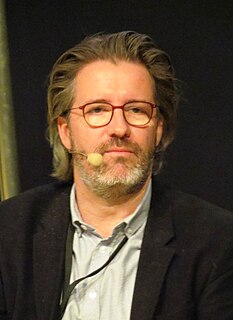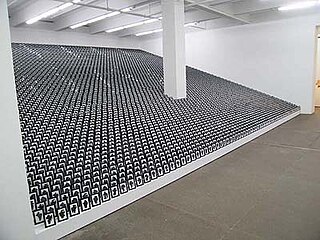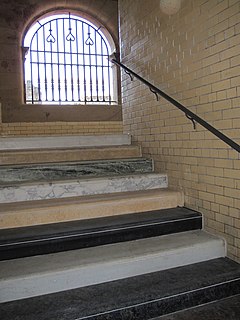
The Turner Prize, named after the English painter J. M. W. Turner, is an annual prize presented to a British visual artist. Between 1991 and 2016, only artists under the age of 50 were eligible. Awarding the prize is organised by the Tate gallery and usually staged at Tate Britain, though in recent years the award ceremony has sometimes been held in other UK cities. Since its beginnings in 1984 it has become the UK's most publicised art award. The award represents all media.

Mark Wallinger is a British artist, best known for his sculpture for the empty fourth plinth in Trafalgar Square, Ecce Homo (1999), and State Britain (2007), a recreation at Tate Britain of Brian Haw's protest display outside parliament. He won the Turner Prize in 2007 for his work State Britain. He is a studio holder at The Bomb Factory Art Foundation in Archway, North London.

Gilbert Prousch, sometimes referred to as Gilbert Proesch, and George Passmore, are two artists who work together as the collaborative art duo Gilbert & George. They are known for their distinctive and highly formal appearance and manner in performance art, and also for their brightly coloured graphic-style photo-based artworks. In 2017, the artists celebrated their 50th anniversary.
Martin Creed is a British artist, composer and performer. He won the Turner Prize in 2001 for exhibitions during the preceding year, with the jury praising his audacity for exhibiting a single installation, Work No. 227: The lights going on and off, in the Turner Prize show. Creed lives and works in London.
Layla Rosalind Nashashibi is a Palestinian-English artist based in London. Nashashibi works mainly with 16mm film but also makes paintings and prints. Her work often deals with everyday observations merged with mythological elements, considering the relationships and moments between community and extended family
The year 2001 in art involves various significant events.

Sir Nicholas Andrew Serota, is an English art historian and curator, who served as the Director of the Tate from 1988 to 2017. He is currently Chair of Arts Council England, a role which he has held since February 2017.
Events from the year 2000 in art.

Olafur Eliasson is an Icelandic–Danish artist known for sculptures and large-scale installation art employing elemental materials such as light, water, and air temperature to enhance the viewer’s experience. In 1995 he established Studio Olafur Eliasson in Berlin, a laboratory for spatial research. In 2014, Eliasson and his long-time collaborator, German architect Sebastian Behmann founded Studio Other Spaces, an office for architecture and art. Olafur represented Denmark at the 50th Venice Biennale in 2003 and later that year installed The Weather Project, which has been described as "a milestone in contemporary art", in the Turbine Hall of Tate Modern, London.

Rachel Jordan is a British artist and has been a frequent guest exhibitor with the Stuckists. For Stuckist shows she created satirical figurative paintings; however, her main body of work is abstract paintings and drawings, alluding to cellular forms.
Art intervention is an interaction with a previously existing artwork, audience, venue/space or situation. It has the auspice of conceptual art and is commonly a form of performance art. It is associated with the Viennese Actionists, the Dada movement and Neo-Dadaists. Stuckists have made extensive use of it to affect perceptions of artworks they oppose and as a protest against existing interventions.

Cornelia Ann Parker OBE, RA is an English visual artist, best known for her sculpture and installation art.

Stuckist demonstrations since 2000 have been a key part of the Stuckist art group's activities and have succeeded in giving them a high-profile both in Britain and abroad. Their primary agenda is the promotion of painting and opposition to conceptual art.

Neo-conceptual art describes art practices in the 1980s and particularly 1990s to date that derive from the conceptual art movement of the 1960s and 1970s. These subsequent initiatives have included the Moscow Conceptualists, United States neo-conceptualists such as Sherrie Levine and the Young British Artists, notably Damien Hirst and Tracey Emin in the United Kingdom, where there is also a Stuckism counter-movement and criticism from the 1970s conceptual art group Art and Language.
Matthew Higgs is an English artist, curator, writer and publisher. His contribution to UK contemporary art has included the creation of Imprint 93, a series of artists’ editions featuring the work of artists such as Martin Creed and Jeremy Deller. During the 1990s he promoted artists outside the Young British Artists mainstream of the period.
Mark Leckey is a British contemporary artist, working with collage art, music and video. His found object art and video pieces, which incorporate themes of nostalgia and anxiety, and draw on elements of pop culture, span several videos. In particular, he is known for Fiorucci Made Me Hardcore (1999) and Industrial Light and Magic (2008), for which he won the 2008 Turner Prize.

Tate Britain, known from 1897 to 1932 as the National Gallery of British Art and from 1932 to 2000 as the Tate Gallery, is an art museum on Millbank in the City of Westminster in London, England. It is part of the Tate network of galleries in England, with Tate Modern, Tate Liverpool and Tate St Ives. It is the oldest gallery in the network, having opened in 1897. It houses a substantial collection of the art of the United Kingdom since Tudor times, and in particular has large holdings of the works of J. M. W. Turner, who bequeathed all his own collection to the nation. It is one of the largest museums in the country. The museum had 391,595 visitors in 2020, a drop of 78 per cent from 2019 due to COVID-19 pandemic closures, but still ranked 52nd on the list of most-visited art museums in the world.
The 2007 Turner Prize for modern British art was awarded on 3 December 2007. It was the 22nd Turner Prize competition. There were four nominees for the 2007 prize and the winner was Mark Wallinger.

The Scotsman Steps is a permanent installation by British artist Martin Creed in Edinburgh, Scotland.

EVERYTHING IS GOING TO BE ALRIGHT is a series of installations by British artist Martin Creed. Each installation consists solely of the artwork title, formed in large neon letters and is numbered individually in Creed's catalogue. The artworks have been described as one of Creed's most iconic works.











